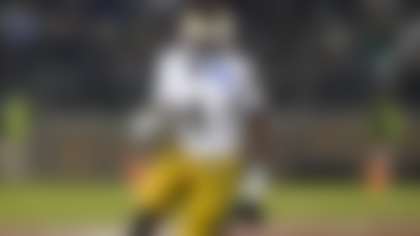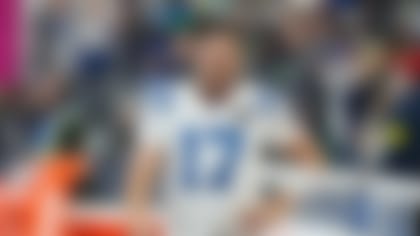The NFL Scouting Combine is under way -- drills begin this weekend and run through Tuesday. The combine originated as a means of reducing the cost of administering physicals to draft-eligible players before the selection process in April. It has become much, much more than that.
Now the combine is a player evaluation tool, a meeting place for coaches and front-office executives around the league, an agent certification seminar, a media event and a place where deals get done. Here are 10 things to keep an eye on this weekend as you tune into NFL Network coverage and keep up with the events on NFL.com:
1. Results of the physical exams
Taking a battery of physical exams is still a critical component to the combine. Each player will take a series of physicals many times, repeating the same test over and over again with a different set of team doctors. Many players will be sent for X-rays and MRIs, and then scheduled for more exams later this spring.
Pay close attention to the tight ends in this year's draft class, because three of the top candidates are coming off medical issues that have to be resolved before teams know where to rank them on their draft boards. Also, the doctors will discover a number of injuries that were previously unknown.
I remember in 1993 when Georgia running back Garrison Hearst had already passed four physicals -- and on the fifth series of tests, it was discovered that he had an ACL issue in his knee. That information spread like wildfire around the combine. Look for a similar situation from a top-ranked player this year.
2. Who skips the workouts?
It is frustrating for clubs to spend all the time and money to hold the combine and then have athletes decide not to participate in the testing and or position drills. Top wide receiver prospect Michael Crabtree has already declared he will not run in Indianapolis and top quarterback Matthew Stafford has notified the NFL he will not throw.
As long as coaches and scouts all show up at the college pro days to watch the players perform, this kind of thing will continue. More players have opted to perform in Indianapolis since the NFL Network started covering the event on television, but I always felt that if a guy doesn't intend to compete then another prospect should take his place. Watch for some late surprises as more players declare they will not run, lift or jump.
3. Workout results
Inevitably, some players are going to light it up in the 40-yard dash and the short shuttle, or throw around 225 pounds on the bench press like it's nothing. Look for a number of the cornerbacks and wide receivers to run sub-4.4 40 times. There will be total silence in the stadium if and when the following guys go to the starting line, 40 yards away from some real money: Wide receivers Jeremy Maclin, Percy Harvin and Darrius Heyward-Bey, and corners Malcolm Jenkins, Vontae Davis, and Darius Butler.
For me, the short shuttle is a more interesting test than the 40-yard dash for most positions. Football is a game played with lots of change of direction. Any athlete running under four seconds in the short shuttle can really change direction. As for the bench press, it says more about a player's dedication to the weight room than it does about functionable football strength.
4. Interview flops and pops
So many players come to the combine prepped for their interviews with team reps. They can spit out canned answers all night long. Coaches and front office people need to be good interviewers to drill down and break through the pre-combine interview prep. The mission of the interview is to really find out how much these guys love football, what they know about the game and an indication of their football intelligence. Word will travel fast about which players flop in the interview process and which guys light up the room. I will host my Sirius radio show from the combine Sunday and Monday, and hopefully I will get some feedback from the completed interviews. I have already met with a number of players headed to Indy and I'm pretty sure players such as center Alex Mack, RB Knowshon Moreno, FB Tony Fiammetta, WR Brian Robiskie, DE Connor Barwin, DE Lawrence Sidbury, DT B.J. Raji, and LB Larry English will do well in the interview segment of the weekend.
5. Fast risers
There is no doubt a few players currently hovering in the middle rounds at this early stage of the evaluation process will move up significantly during combine week. An athlete who measures an inch taller than expected, runs two-tenths of a second faster than expected, jumps farther than anticipated and looks real smooth in his drills can climb the draft boards.
A lot of people want to see QB Josh Freeman perform and see DE Michael Johnson clear up some issues that damaged his draft position. And who will emerge as the third-ranked defensive tackle in this draft after Raji and Peria Jerry?
6. Significance of certain workouts
Not every test has the same value to every position. An offensive tackle's 40 time isn't as important as a wide receiver's. A receiver's bench press results don't mean as much as an inside linebacker's. A cornerback's vertical leap means more to most scouts than a center's jump. The problem today for most scouts when they break down the test results is figuring out how much of what they just measured is manufactured -- an illusion that is the product of spending six to eight weeks doing nothing but practicing for these drills.
Target numbers
Gil Brandt has a look at numbers that would be considered good for each position. If a prospect hits these numbers, he is definitely worthy of further evaluation. More ...
I look for two things as the test results come in over the weekend. Was a player's short shuttle time close to half-a-second under his 40 time? For example, a linebacker who runs 4.9 in the 40 appears too slow -- but if his short shuttle is under 4.4, he's worth a longer look because he can move with quickness. I also like to add up the bench press, vertical leap and the standing broad jump to get a feel for the explosive nature of the athlete. Thirty reps on the bench, a 10-foot broad jump and a 32-inch vertical leap add up to 72. Any combination close to 70 is good.
A number of NFL people are interested in the 10-yard split in the 40. When you watch the combine, you will notice evaluators such as Bill Parcells and Gil Brandt sitting near the start of the 40-yard dash, watching the first 10 yards. Al Davis and Ron Wolf were always seated in the same spot for years.
7. Coaching business
The combine is usually the last opportunity to fill out a coaching staff. I have had a number of friends get coordinator jobs or position coaching spots at the combine. Keep an eye on the stands during the TV coverage and watch for a head coach with an opening on his staff sitting with an unemployed coach.
8. Backroom deals
With virtually every NFL agent in town for the weekend and every GM also in a hotel room for the next five nights, it is a tremendous time to iron out a few player contracts and extensions. With free agency starting up just days after the combine ends, there are a lot of off-the-record talks about potential clients.
9. Agents signing players
The lobby of the Holiday Inn, where the players are housed for the weekend, is always packed with agents trying to sign the remaining players who have yet to pick an agent. Agents also are there to protect clients from other agents who wouldn't think twice about recruiting a player who is already signed. There also are a number of agents working the lobby on behalf of prospects who did not get invited to the combine.
I remember a few years ago, a number of us jumped in a cab and went about 20 minutes outside of town to watch a few kids work out. The agent brought his non-combine players to Indy and rented a facility just to let the guys demonstrate what they could do. Keep in mind there will be about 25 to 30 players drafted -- nearly one round's worth -- who are not at the combine.
10. St. Elmo
Every night of the combine, St. Elmo Steak House on South Illinois Street is packed with NFL people talking football, the results of the day's testing and what's going on around the league. If you're in town and lucky enough to get a table, you won't believe the number of NFL faces coming and going. From Jerry Jones to Bill Belichick to most of the new head coaches around the NFL, a stop at St. Elmo' is on everyone's to-do list.



